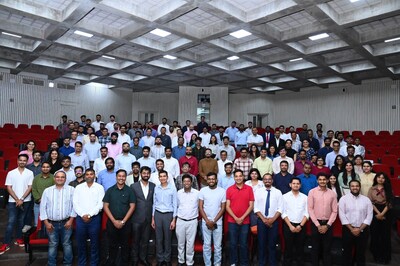Joel D. Montgrand is having a banner year.
The Saskatchewan actor from Peter Ballantyne Cree Nation near Prince Albert said up until recently, he was only recognized for bit parts, “one-liners” and fleeting moments in your favourite shows. But within the past two months, he’s made his debut in HBO’s smash hit True Detective: Night Country alongside Jodie Foster, and in what was one of the most highly anticipated Netflix series in recent memory: Avatar: The Last Airbender.
He says that success likely wouldn’t have come without the industry breaking down around him in a very specific way.
“Being Indigenous, where I grew up, I never dreamed that I would ever get to be an actor because you had to move,” he told CBC News. “Nowadays, people are auditioning from all across the country from their own hometowns. There’s no limit.”
For better or worse, he says, the self-tape — when actors tape themselves auditioning at home instead of meeting in person with casting directors — is quickly becoming an entrenched part of the industry.
While self-tapes have always been part of the acting world, they’ve become a much larger part of it after the COVID-19 pandemic shuttered active projects, then forced casting agents to find ways to audition actors while still following social distancing policies.
Montgrand sees it as a positive move that helped him land the role of Eddie Qavvik in Night Country, and one he says is helping actors score more opportunities.
“What has happened in the acting world, with me and a lot of my friends, is that auditions have skyrocketed,” he said. “If someone say, would average maybe 50 auditions in a year, suddenly they’re doing 100.”
But as self-tapes are helping to change how auditioning works, others aren’t so sure that change is a beneficial one.
While Toronto producer and actor Julian De Zotti does recognize the significant advantages that self-taping auditions can provide, he says the incursion is similar to labour issues in other industries where workers are expected to learn skills before landing a job.
“A lot of employers just think that ‘Well, you can learn that on your own time, and you should be able to just show up and do it,’ ” he said. “That has always been in our business. And now it’s just manifested itself in a different way — with self-tapes.”
Both Montgrand and De Zotti say the increasing reliance on self-tapes can mean a bigger workload for actors since they have to tape themselves. And while actors who self-tape may double the amount of auditions they’re able to attend, Montrgrand says it doesn’t necessarily mean they automatically double the number of roles they land. Because as their capacity to audition increases, so, too, does their competition.
“If they booked say, four of those 50 or whatever it is, they would still book four out of that 100,” he said.
That leads to more chances but not necessarily to more work — and, in some cases, decidedly less money in their bank accounts, because they are now required to buy or rent equipment and software and invest in training just to tape an audition.
Eleanor Noble, an actor and president of Canadian acting union ACTRA, said the increased expectation of self-taping auditions have had a direct monetary impact on performers, who only earn $10,000 a year on average in Canada.
Hollywood actors have reached a tentative agreement with major studios to end the second of two strikes that upended the entertainment industry. The National’s Ian Hanomansing talks to ACTRA negotiator Marie Kelly and Canadian actor Ali Momen about what the deal means for work on this side of the border.
Prior to the pandemic, Noble said, an acting audition would typically take place at a casting house, which would provide a camera, lights and reading partner. After performing their part once, the actor would be provided notes by a director, producer or casting director before being allowed to read again.
Now, she says, actors are expected to create a full at-home auditioning space with cameras, lighting and editing software at the ready — as well as learn how to physically operate all that equipment, and take the time to learn skills like cinematography, editing and lighting design. Essentially, says Noble, it requires auditioning actors to become part-time independent filmmakers just to book a role.
“There was a lot of work downloaded onto the performers off the shoulders of the casting directors and we were never financially compensated for that,” she said.
That’s coupled with the fact that actors aren’t compensated for the preparation work they do to memorize pages of dialogue and build characters for auditions, Noble said.
“The only time that we are paid and can earn a livelihood is when we do land the role.”
Noble says working from home creates the ability (and therefore the expectation) for actors to keep recording until they get a perfect take — both based on their performance, and on whether a pet, child, neighbour or other elements of their real life interrupts.
Industry regulation
These concerns have already resulted in industry action. Last year, when studios began advertising access to their cameras, lights, reading partners and editing software for large fees, the U.S. performer’s union SAG-AFTRA called the move an “optical and ethical disaster.”
That issue became a central fixture in the Hollywood strikes, and in the eventual agreement reached between SAG-AFTRA and movie studios, specific guidelines were established. Now, producers are limited in the number of pages they can ask actors to perform, the video resolution they can require and equipment they can ask performers to use.
Both ACTRA and Equity, the U.K.’s acting union, have made similar attempts at oversight. Each have “best practice” documents to guide how producers should conduct self-tape requests, though both documents include the identical line that “these provisions will not always prove practical due to the fluid nature of our business.”
A group of U.K. actors launched their own, more comprehensive document early in 2023, writing that, “the current framework is ad hoc and unregulated and … must be urgently revised and updated in consultation with the actors it concerns and whose livelihoods it affects.”
Noble says ACTRA is currently negotiating more strict regulations for their upcoming contract with movie studios.
Greater range of auditions
Even as challenges surrounding self-tapes increased for actors, it’s unlikely they’ll ever fade completely due to the casting benefits they offer.
Casting director Deirdre Bowen says she’s embraced virtual auditions and self-tapes, because it gives her a greater sample of auditions to choose from.
“I can see a lot more auditions because I don’t have to have people lined up out there,” she said. ” I have a much bigger net.”
That means she can consider actors she normally wouldn’t — performers who have less experience than the ten people she’d normally bring in to audition in person.
While that can make it tougher for actors, she says it also increases the talent pool.
Noble, Montgrand and De Zotti all recognize that as a benefit and accept that the practice of self-taping is likely here to stay. What they and others are more concerned about is whether those actors will be protected from an industry that has already set a tradition of demanding unpaid labour.








